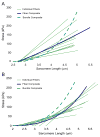Elucidation of extracellular matrix mechanics from muscle fibers and fiber bundles
- PMID: 21092966
- PMCID: PMC3042517
- DOI: 10.1016/j.jbiomech.2010.10.044
Elucidation of extracellular matrix mechanics from muscle fibers and fiber bundles
Abstract
The importance of the extracellular matrix (ECM) in muscle is widely recognized, since ECM plays a central role in proper muscle development (Buck and Horwitz, 1987), tissue structural support (Purslow, 2002), and transmission of mechanical signals between fibers and tendon (Huijing, 1999). Since substrate biomechanical properties have been shown to be critical in the biology of tissue development and remodeling (Engler et al., 2006; Gilbert et al., 2010), it is likely that mechanics are critical for ECM to perform its function. Unfortunately, there are almost no data available regarding skeletal muscle ECM viscoelastic properties. This is primarily due to the impossibility of isolating and testing muscle ECM. Therefore, this note presents a new method to quantify viscoelastic ECM modulus by combining tests of single muscle fibers and fiber bundles. Our results demonstrate that ECM is a highly nonlinearly elastic material, while muscle fibers are linearly elastic.
Published by Elsevier Ltd.
Conflict of interest statement
Figures



References
-
- Borschel GH, Dennis RG, Kuzon WM., Jr Contractile skeletal muscle tissue-engineered on an acellular scaffold. Plast Reconstr Surg. 2004;113:595–602. discussion 603–594. - PubMed
-
- Buck CA, Horwitz AF. Cell surface receptors for extracellular matrix molecules. Annu Rev Cell Biol. 1987;3:179–205. - PubMed
-
- Engler AJ, Sen S, Sweeney HL, Discher DE. Matrix elasticity directs stem cell lineage specification. Cell. 2006;126:677–689. - PubMed
Publication types
MeSH terms
Grants and funding
LinkOut - more resources
Full Text Sources

